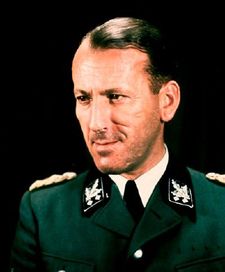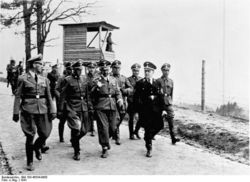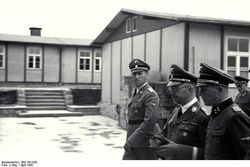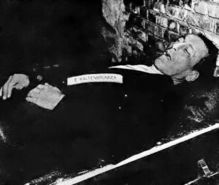| On this page |
|---|
| Word Browser |
| Ernst Kaltenbrunner | |
 Obergruppenführer und General der Polizei und Waffen-SS Dr. Ernst Kaltenbrunner, Chief of the RSHA and President of Interpol. | |
|
| |
|---|---|
| In office 30 January 1943 – 12 May 1945 | |
| Appointed by | Adolf Hitler |
| Preceded by | Reinhard Heydrich & Heinrich Himmler (acting) |
| Succeeded by | None |
|
| |
| In office 30 January 1943 – 12 May 1945 | |
| Preceded by | Arthur Nebe |
| Succeeded by | Florent Louwage |
|
| |
| Born | 4 October 1903 Ried im Innkreis, then Austria-Hungary, now Austria |
| Died | 16 October 1946 (aged 43) Nuremberg, Germany |
| Nationality | Austrian |
| Political party | National Socialist German Workers' Party (NSDAP) |
| Spouse(s) | Elisabeth Eder (married 14 January 1934) |
| Alma mater | University of Graz |
| Profession | Lawyer |
| Religion | Roman Catholic |
| Military service | |
| Service/branch | |
| Years of service | 1940-1945 |
| Rank | Obergruppenführer und General der Polizei und Waffen-SS |
| Battles/wars | World War II |
| Awards | Knights Cross of the War Merit Cross with Swords |
Ernst Kaltenbrunner (4 October 1903 – 16 October 1946) was a senior Austrian official during World War II, holding the offices of Chief of the RSHA, and President of Interpol from 1943 to 1945. He was the highest-ranking SS leader to face trial at the first Nuremberg Trials, having the full rank of Obergruppenführer und General der Polizei und Waffen-SS. He was found guilty of war crimes and crimes against humanity and executed.
Biography
Early life
Born in Ried im Innkreis, Austria, Kaltenbrunner was the son of a lawyer, and was educated at the State Realgymnasium in Linz and at Graz University. He obtained a law degree in 1926, and briefly worked as a lawyer in Linz and Salzburg. He was a very tall man, standing just over 6' 7" (201 cm) tall,[citation needed] and had deep scars on his face from dueling in his student days.[1] However, according to some sources, these "dueling scars" were actually the result of an alcohol-linked driving accident.[2]
Early career

Kaltenbrunner joined the Nazi Party and the SS in Austria in 1932. He was the Gauredner (district speaker) and Rechtsberater (legal consultant) of the SS Division VIII. In January 1934, Kaltenbrunner was briefly jailed by the Engelbert Dollfuss government with other National Socialists at the Kaisersteinbruch concentration camp. In 1934, he was jailed again on suspicion of High Treason in the assassination of Dollfuss. This accusation was dropped, but he was sentenced to six months for conspiracy. In 1934, Kaltenbrunner married Elisabeth Eder (b. 1908) and they had three children. In addition to the children from his marriage, Kaltenbrunner had twins, Ursula and Wolfgang, (b. 1945) with his long-time mistress Gisela Gräfin von Westarp (née Wolf). All of his children survived the war.
From mid-1935 Kaltenbrunner was the leader of the Austrian SS. He assisted in the Anschluss and Hitler promoted him to SS Brigadeführer on the day the Anschluss was completed. On 11 September 1938 he was promoted to the rank of SS Gruppenführer (see Video of Kaltenbrunner in Vienna January 1939). He was also a member of the Reichstag from 1938.
World War II
In July 1940, he was commissioned as a Untersturmführer in the Waffen-SS Reserve.[4] Later in April 1941, he was promoted to Major General (Generalleutnant) of the Police. On 30 January 1943 Kaltenbrunner was appointed Chief of the RSHA, composed of the SiPo (Sicherheitspolizei: the combined forces of the Gestapo and KriPo) along with the SD (Sicherheitsdienst: Security Service). He replaced Reinhard Heydrich, who was assassinated in June 1942. Kaltenbrunner held this position until the end of the war. He was promoted to SS Obergruppenführer und General der Polizei on 21 June 1943. He also replaced Heydrich as President of the International Criminal Police Commission (ICPC), the organization today known as Interpol.
Toward the end of the war, Kaltenbrunner's power increased greatly, especially after the attack on Hitler of 20 July 1944, upon which he gained direct access to the Führer. He was also responsible for conducting kangaroo trials and calling for the execution of all the people who were accused of plotting against Hitler. It was often said that even Heinrich Himmler feared him and he managed to be an intimidating figure with his height, facial scars and volatile temper. It was rumored that he was responsible for Adolf Eichmann's failure to attain the rank of SS-Colonel. Kaltenbrunner was also long-time friends with Otto Skorzeny and recommended him for many secret missions, allowing Skorzeny to become one of Hitler's valued agents. Kaltenbrunner was also responsible for heading Operation Long Jump, the attempt to assassinate Stalin, Churchill, and Roosevelt. Following Himmler's appointment as Minister of the Interior in August 1943, Kaltenbrunner sent him a letter wherein he argued that Himmler's new powers must be used to reverse the party cadre organisation's annexation.
In December 1944, Kaltenbrunner was granted the rank of General of the Waffen-SS. Other SS General Officers were granted equivalent Waffen-SS ranks in 1944 as well, so that in the event that they were captured by the Allies, they would have status as military officers instead of police officials. For those who had held police rank prior to 1944, the SS General's title could become rather lengthy. Kaltenbrunner was listed on the SS rolls in 1945 as Obergruppenführer und General der Polizei und Waffen-SS. On 9 December 1944 he was awarded the Knights Cross of the War Merit Cross with Swords.[5] In addition he was awarded the Golden NSDAP party badge and the Blutorden.
On 18 April 1945, Himmler named Kaltenbrunner Commander-in-Chief of those remaining German forces in Southern Europe. Kaltenbrunner reorganized his intelligence agencies as a stay-behind underground net. He divided the subcommands between Otto Skorzeny, head of the sabotage units, and Wilhelm Waneck, who kept in contact not only with Kaltenbrunner and other centers in Germany, but also with stay-behind agents in the southern European capitals.[6] In late April 1945, Kaltenbrunner relocated his headquarters from Berlin to Alt-Aussee in Austria. On 12 May 1945 he was captured by a U.S. patrol and arrested.
Nuremberg trials
At the Nuremberg Trials, Kaltenbrunner was charged with conspiracy to commit crimes against peace, war-crimes and crimes against humanity. The most notable witness in this trial was Rudolf Hoess, the camp commander of the Auschwitz concentration camp.
Kaltenbrunner's close control over the RSHA meant that direct knowledge of and responsibility for the following crimes was ascribed to him:
- Mass murders of civilians of occupied countries by Einsatzgruppen
- Screening of prisoner of war camps and executing racial and political undesirables
- The taking of recaptured prisoners of war to concentration camps, where in some cases they were executed
- Establishing concentration camps and committing racial and political undesirables to concentration and annihilation camps for slave labor and mass murder
- Deportation of citizens of occupied countries for forced labor and disciplining of forced labor
- The execution of captured commandos and paratroopers and protection of civilians who lynched Allied fliers
- The taking of civilians of occupied countries to Germany for secret trial and punishment
- Punishment of citizens of occupied territories under special criminal procedure and by summary methods
- The execution and confinement of people in concentration camps for crimes allegedly committed by their relatives
- Seizure and spoliation of public and private property
- Murder of prisoners in SIPO and SD prisons
- Persecution of Jews
- Persecution of the churches
- Torture of gypsies
During the initial stages of the Nuremberg trials, Kaltenbrunner was absent because of two episodes of subarachnoid hemorrhage. His lawyer Kurt Kaufmann requested that Kaltenbrunner was medically unfit for the trial and to be acquitted on grounds of health complications.[7] Kaltenbrunner's state of health improved and the tribunal denied his request for pardon. When Kaltenbrunner was released from a military hospital he pleaded not guilty to the charges of the indictment served on his person. Kaltenbrunner stressed during cross examination that all decrees and legal documents which bore his signature were "rubber stamped" and filed by his adjutant(s).[8] Kaltenbrunner was incumbent in his defense that Himmler was culpable for the atrocities committed during his tenure as chief of the RSHA. During the trial he stressed that his position existed only in title and was only committed to matters of espionage and intelligence. The IMT (International Military Tribunal) noted that Kaltenbrunner was a keen functionary in matters involving the sphere of the RSHA's intelligence network, but the evidence also showed that Kaltenbrunner was an active authority and participant in many instances of war crimes and crimes against humanity. On September 30, 1946 the IMT found Kaltenbrunner not guilty in matters of conspiracy for aggression concerning the charge of the indictment. However, Kaltenbrunner was found guilty of war crimes and crimes against humanity. On October 1, 1946 the IMT sentenced Ernst Kaltenbrunner to death by hanging.[9]
Death
Kaltenbrunner was executed by hanging at around 1:40 a.m. on 16 October 1946. Kaltenbrunner's last words were:
| “ | I have loved my German people and my fatherland with a warm heart. I have done my duty by the laws of my people and I am sorry this time my people were led by men who were not soldiers and that crimes were committed of which I had no knowledge. Germany, good luck. | ” |
Further evidence
In 2001, Ernst Kaltenbrunner's personal Nazi security seal was found in an Alpine lake, 56 years after he threw it away in an effort to hide his identity. The seal was recovered by a Dutch citizen on vacation. The seal has the words "Chef der Sicherheitspolizei und des SD" (Chief of the Security Police and SD) engraved on it. Experts have examined the seal and believe it was thrown in the final days of the war in May 1945. It was one of Kaltenbrunner's last acts as a free man. Kaltenbrunner gave himself up claiming to be a doctor and offering a false name. However, his mistress spotted him, and by chance occurrence, she called out his name and rushed to hug him. This action tipped off the Allied troops, resulting in his capture, trial, and execution.[10]
Portrayal in popular culture
Film and television
Ernst Kaltenbrunner has been portrayed by the following actors in film, television and theater productions.[11]
- Christopher Heyerdahl in the 2000 Canadian/U.S. T.V. production Nuremberg
- Hans Meyer in the 1982 United States television production Inside the Third Reich.
- John Moffatt in the 1981 British television series Private Schulz.
- Hans Meyer in the 1978 United States T.V. miniseries Holocaust.
- Mikhail Zharkovsky in the 1973 Russian T.V. mini-series Semnadtsat mgnoveniy vesny (Seventeen Moments of Spring).[12]
- Alain Nobis in the 1972 French television production La Tragédie de Vérone.
- Branko Plesa in the 1971 Yugoslavian television production Nirnberski epilog.
- Edward Underdown in the 1958 British film The Two-Headed Spy.
A character in the movie The Return of the Living Dead is named Ernie Kaltenbrunner after him.
Books
- Ernst Kaltenbrunner: Ideological Soldier of The Third Reich is a biographical work about Kaltenbrunner by Peter R. Black.
- Nuremberg Diary is an account of the Defendants at Nuremberg by G. M. Gilbert.
- The Nuremberg Interviews is a descriptive, yet autobiographical account of the Defendants at Nuremberg by Leon Goldensohn. Kaltenbrunner has his own section in his own words in this book.
- Freemasonry: Ideology, Organization, and Policy is a book about Freemasonry published with a foreword by Kaltenbrunner.
- Hitler's Elite is a book by Louis L. Snyder compiling all of Hitler's top henchmen and has a section entirely for Kaltenbrunner.
- Gestapo: Instrument of Tyranny is a book by Edward Crankshaw that investigates the atmosphere within the Gestapo hierarchy and includes some information about Kaltenbrunner.
- Colonization: Down to Earth, a fictional account of historic events merged with an alternate history, Harry Turtledove creates a scenario where Kaltenbrunner is the successor of Himmler as the third Führer and Reich Chancellor of the Greater German Reich and triggers a war between Nazi Germany and alien settlers, a war that results in the destruction of the Reich and the death of Kaltenbrunner himself.
Summary of his SS career
Dates of rank
- SS-Mann - 31 August 1931
- SS-Oberscharführer - c. 1932
- SS-Sturmhauptführer - 25 September 1932
- SS-Standartenführer - 20 April 1936
- SS-Oberführer - 20 April 1937
- SS-Brigadeführer - 12 March 1938
- SS-Gruppenführer - 11 September 1938
- SS-Untersturmführer d.R. - 1 July 1940
- Generalleutnant der Polizei - 1 April 1941
- SS-Obergruppenführer und General der Polizei - 21 June 1943
- General der Waffen-SS - 1 December 1944[4]
Notable decorations
- Honour Dagger of the SS
- Honour Chevron for the Old Guard
- SS-Membershipspin Nr. 160,180
- SS-Honour Ring
- SS-Julleuchter
- Honour Sword of the Reichsführers-SS
- SS Long Service Award For 4, 8, and 12 Years Service
- Long Service Award of the NSDAP in Bronze and Silver
- Anschluss Medal (1938)
- Sudetenland Medal (1938) with Prague Castle Bar (1939)
- Golden Party Badge (1939)
- Blood Order (1942)
- War Merit Cross Second (1942) and First (1943) Classes with Swords
- German Cross in Silver (1943)
- Knights Cross of the War Merit Cross with Swords (1944)[13]
See also
Notes
- ^ Ernst Kaltenbrunner
- ^ The Nuremberg Trials
- ^ This image is from the Bundesarchiv.
- ^ a b A Complete Biography of Ernst Kaltenbrunner - Promotions
- ^ Fsefehlsblatt of the Security Police and SD (51): 361.
- ^ The Last Days of Ernst Kaltenbrunner
- ^ Goldensohn, L. (2004), The Nuremberg Interviews Conversations with the Defendants and Witnesses, United States of America: Pimlico
- ^ Owen, J. (2006), Nuremberg Evil On Trial, Great Britain: Headline Review
- ^ Persico, J. (1994), Nuremberg Infamy on Trial, United States of America: Penguin Books
- ^ Nazi chief's seal found in Alpine lake
- ^ "Ernst Kaltenbrunner (Character)". IMDb.com. Retrieved May 8, 2008.
- ^ ""Semnadtsat mgnoveniy vesny" (1973)". IMDb.com. Retrieved May 8, 2008.
- ^ A Complete Biography of Ernst Kaltenbrunner - Decorations & Awards
External links
- Video of a Parade with Kaltenbrunner in January 1939
- Audio recording of Kaltenbrunner at Nuremberg Trial
- Kaltenbrunner defense broadcast during Nuremberg Trial
- Testimony of Rudolf Hoess in the Nuremberg Trial
- Kaltenbrunner's seal found in Alpine lake
- Nuremberg film
- Seventeen Moments of Spring film
- The Return of the Living Dead
- Holocaust miniseries
- Colonization: Down to Earth
- "Ernest Kaltenbrunner" at Find-A-Grave
| Government offices | ||
|---|---|---|
| Preceded by Heinrich Himmler (acting) |
Director of the Reich Main Security Office 30 January 1943 - 12 May 1945 |
Succeeded by None |
| Preceded by Arthur Nebe |
President of Interpol 30 January 1943 - 12 May 1945 |
Succeeded by Florent Louwage |
| Military offices | ||
| Preceded by None |
Commander-in-Chief of Southern Germany 18 April 1945 - 2 May 1945 |
Succeeded by Albert Kesselring |
| |||||||||||||||||
| ||||||||||||||||||||||||||
| Persondata | |
|---|---|
| Name | Kaltenbrunner, Ernst |
| Alternative names | |
| Short description | Nazi official executed for war crimes |
| Date of birth | 4 October 1903 |
| Place of birth | Ried im Innkreis, Austria-Hungary |
| Date of death | 16 October 1946 |
| Place of death | Nuremberg, Germany |
Want to thank TFD for its existence? Tell a friend about us, add a link to this page, add the site to iGoogle, or visit the webmaster's page for free fun content.
Link to this page:
Please bookmark with social media, your votes are noticed and appreciated:
| ?Page tools | ||
|---|---|---|
|
| ?My Word List |
|---|
| Add current page to the list |
| ?Charity |
|---|
 Feed a hungry child - donate to school feeding program Feed a hungry child - donate to school feeding program |




